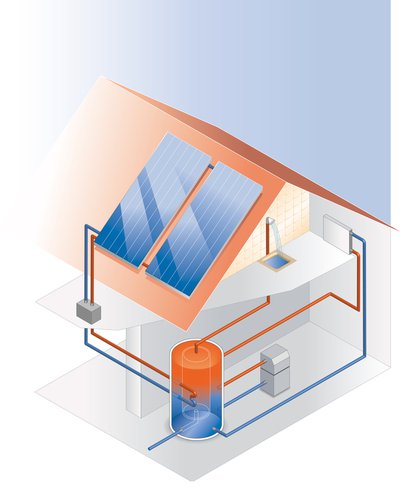The expansion of solar technology leads to more effective power and heat generation. In this article we explain solar thermal, which is very suitable for the sustainable production of hot water and, to a lesser extent, for the production of heating energy.
The sun, already 4.5 billion years old, is an almost unlimited source of energy. The fraction of their energy that reaches Earth is about 10,000 times more than the energy needs of all humankind.

Solar thermal systems for sustainable hot water preparation and heating
Solar thermal systems convert solar radiation into thermal energy. When a collector “collects” the solar energy, thermal energy is generated by the solar radiation. The thermal energy obtained in this way is primarily used for the hot water requirements of the house. The water is passed through collectors and heated. This only works with a so-called buffer tank, because the peak demand for hot water usually occurs in the morning or evening, while the sun’s rays are strongest at midday.
The principle of solar thermal energy can also relieve the heating system. In warmer seasons, a solar thermal system can carry up to 100% of the heat output. In winter, however, the heating energy that can be obtained from solar thermal energy is not sufficient. It can only be used here as a support for other heating systems (e.g. fireplace, gas heating, underfloor or central heating).
Size of the energy storage and expected hot water demand
In order to use the energy of the midday sun optimally, the systems must store the thermal energy obtained for as long as possible. So-called bivalent storage systems are used here. If the heat generated by solar energy is not sufficient, the existing heating system (gas, oil or pellet boiler, etc.) will reheat it using the so-called post-heating heat exchanger.
The size of the storage tank, and therefore its cost, varies depending on the size of the system, which depends on the domestic hot water needs. Therefore, before building a solar thermal system, it is estimated how large the hot water requirement will be. Because this results in the size of the system and the storage. If the system is too small, the demand cannot be satisfied even in summer and you have to pay extra. If the system is too large, thermal energy remains unused and is lost.
It is worth thinking about this potential early in the planning phase of building a house, because it can save costs compared to retrofitting.
Funding and financing options for a solar thermal system
There are funding and financing options for the construction of solar thermal systems. Among other things, the Federal Office of Economics and Export Control (BAFA for short) offers financial support. Depending on the size and type of solar thermal system, this can vary greatly (see table). It should also be noted that BAFA only supports construction on existing buildings.
Alternatively, the federal development bank KfW offers low-cost loans to finance the construction of solar thermal systems. Find out more about the KfW development bank here.
Funding overview for solar collector systems
| Construction of a solar collector system for… | basic funding | |
| exclusive water heating | 3 to 10 m² gross collector area | 500€ |
| 11 to 40 m² gross collector area | 50€/m² gross collector area | |
| combined hot water preparation and heating support, solar cooling or heating network supply | up to 14 m² gross collector area | €2,000 |
| 15 to 40 m² gross collector area | 140€/m² gross collector area |
We have summarized the advantages and disadvantages for you below:
| Advantages of solar thermal | Disadvantages of solar thermal |
| satisfies almost 100% of the hot water requirement in summer – on average around 50% throughout the year | can only be used seasonally or during the day, which is why you need an additional heating system |
| protects the heating in the transitional period | uses a lot of energy in production, so its energy balance is only positive after a long period of use |
| uses the heat from solar energy directly and is therefore environmentally friendly | requires a memory that takes up a lot of space depending on its size |
| costs €5,000-6,000 on average, so it is comparatively cheap to buy | costs not only in the purchase, but also in the annual maintenance |
This article is based on an interview with Uwe Biermann . He is an expert in the fields of photovoltaics, electricity storage and efficient heating systems . He has been following the renewable energy industry for over 15 years and found his way to the company enersol in 2011, which convinced him with well thought-out solutions for independent energy supply.



